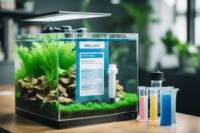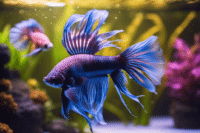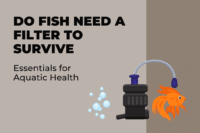Want to quickly boost the oxygen levels in your fish tank? You’re in the right place. Oxygen is vital for the health of your aquarium, keeping fish happy and water clean. Without enough oxygen, fish can struggle to breathe and might even get sick.
One of the simplest and fastest ways to add oxygen is by pouring water from a height back into the tank. This aerates the water immediately, creating bubbles that increase oxygen levels. Another trick includes adding fast swimmers or schooling fish; their movements naturally help circulate water, enhancing oxygen distribution.
Key Takeaways
- Pour water from a height to quickly boost oxygen levels.
- Fish movements can help circulate oxygen-rich water.
- Healthy oxygen levels are crucial for fish well-being.
Understanding Oxygen in Your Aquarium
Ensuring your fish tank has enough oxygen is crucial for the health and vitality of your fish. This section covers why oxygen is important, how to spot low oxygen levels, and how temperature and water movement play a role.
The Role of Oxygen in Fish Tanks
Oxygen is essential for fish and other aquatic life. Fish rely on dissolved oxygen in the water to breathe through their gills. Without sufficient oxygen, fish can become stressed and sick.
Gas exchange happens at the water’s surface where oxygen enters and carbon dioxide leaves. Water circulation enhances this process, keeping oxygen levels stable. Using equipment like air stones or air pumps can help maintain the right level of dissolved oxygen.
Stagnant water can lead to low oxygen levels, which is dangerous for your fish. Keeping the water moving ensures a healthy, oxygen-rich environment.
Signs of Low Oxygen Levels and Why They Occur
Recognizing low oxygen levels can save your fish from distress. Fish gasping at the surface is a clear sign of low oxygen levels. When oxygen is depleted, fish try to breathe air from the water’s surface.
Poor water circulation and stagnant water are common causes. Overcrowding your tank with too many fish can also lower oxygen levels. Certain species have higher oxygen needs and may show signs earlier than others.
If you notice fish being sluggish or not eating, it might be due to low oxygen. Regular testing of your aquarium water can help you catch and fix issues before they become severe.
How Temperature and Water Movement Affect Oxygen
Water temperature and movement play big roles in keeping oxygen levels high. Warmer water holds less dissolved oxygen than cooler water. That’s why you might see your fish struggling more in a heated tank.
Using devices like filters, bubblers, and aerators can increase water movement. This movement ensures better gas exchange at the surface. Keep an eye on your tank’s temperature and try to maintain a balance that supports your fish’s oxygen needs.
Tip: In the summer, keep your aquarium out of direct sunlight to avoid overheating and reducing oxygen levels. Consider using a fan or water chiller to maintain a cool environment.
Quick Fix Solutions to Increase Oxygen
There are several ways to quickly add oxygen to your fish tank. You’ll find methods that offer immediate results, ways to optimize your tank environment, and more permanent solutions for long-term oxygen enrichment.
Immediate Actions for Emergency Oxygen Boost
If you need to quickly boost oxygen levels, using an air pump and air stone is a great solution. Connect an air stone to an air pump and place it in the tank. The bubbles it creates will increase oxygen levels almost immediately.
Another method is pouring water back into the tank from a height. Fill a clean jug with tank water and pour it back from about a foot above. This will aerate the water and quickly introduce more oxygen.
Using a battery-operated air pump is handy if you’re experiencing a power outage. These pumps run on batteries and can keep the oxygen levels stable until normal power returns.
Removing some fish temporarily can also help in emergencies. Overcrowding reduces oxygen availability, so relocating a few fish to another tank can provide immediate relief.
Optimizing Your Tank for Better Oxygenation
For non-emergency adjustments, make sure your tank has adequate water movement. Filters and water pumps can help circulate water better, spreading oxygen throughout the tank.
Adding live plants is another effective method. Plants not only add beauty but also produce oxygen during photosynthesis, especially during daylight hours.
Make sure to maintain clean water conditions. Waste and debris reduce oxygen levels, so regular cleaning and water changes can keep your tank healthier.
Avoid overfeeding your fish. Uneaten food decomposes and consumes oxygen, so give only what your fish can eat in a few minutes.
Permanent Solutions for Oxygen Enrichment
Installing high-quality filtration systems can ensure continuous oxygen flow. Filters that provide both mechanical and biological filtration are particularly good at maintaining high oxygen levels.
Using a water chiller can also help. Cooler water holds more oxygen than warm water, so keeping the temperature in check is crucial.
For long-term solutions, consider creating a waterfall feature. The constant falling water introduces oxygen and also adds a scenic element to your tank.
Lastly, upgrading to a larger tank provides more water volume, reducing competition for oxygen among your fish. Benefits like these make it a worthy investment for serious aquarium enthusiasts.
Conclusion
Adding oxygen to your fish tank is crucial for the health of your fish.
You can use simple methods like pouring water from a height or installing an air stone. These methods are quick and effective.
Air pumps are another popular option. They produce bubbles that increase oxygen levels efficiently.
Plants, too, can help. They not only look good but also help oxygenate the water naturally.
For a stronger boost, try adding an aquarium filter. It improves water movement and oxygen levels at the same time.
Remember to monitor your fish. If they seem more active and healthier, you’re doing a great job!










